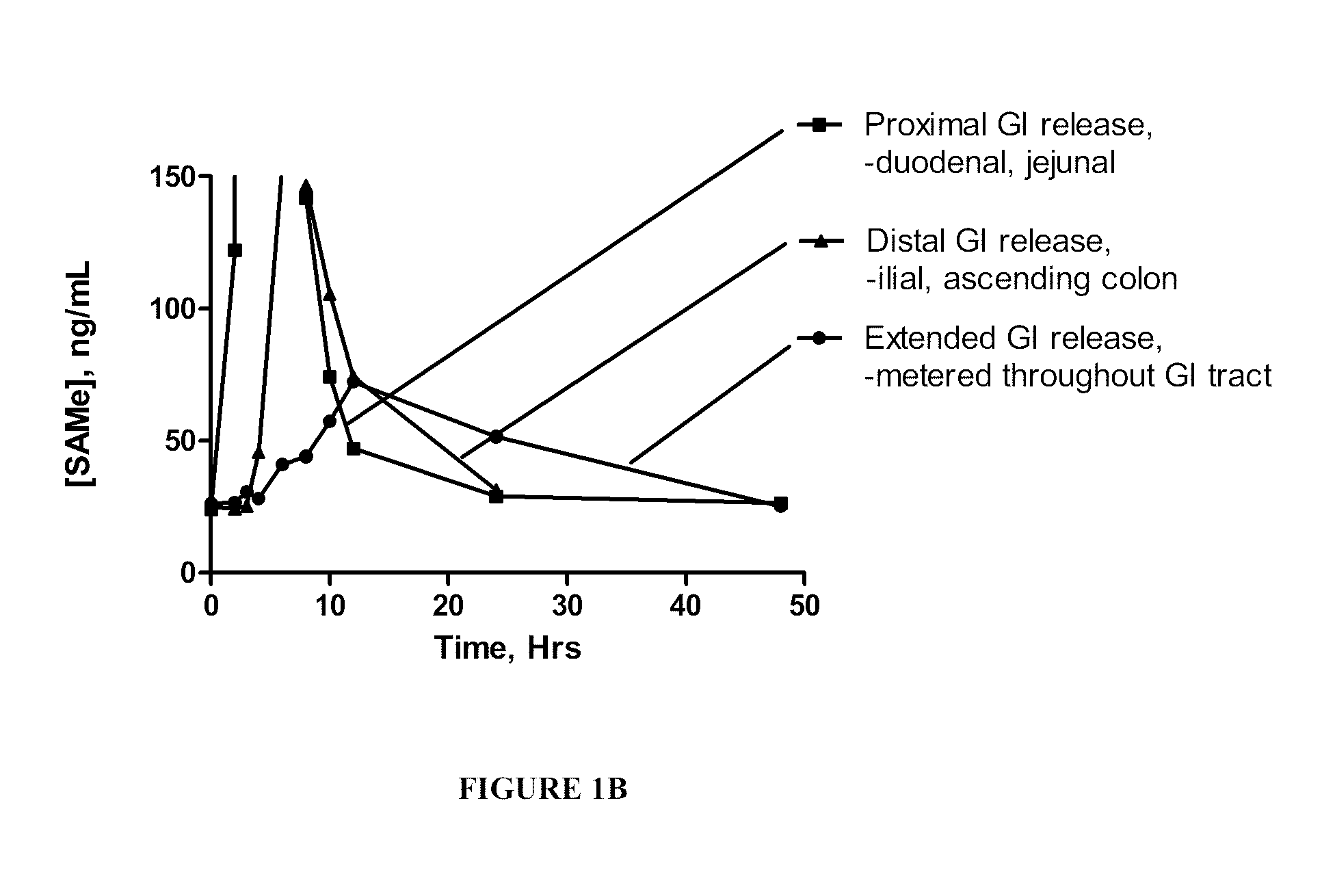S-adenosylmethionine formulations with enhanced bioavailability
a technology of s-adenosylmethionine and bioavailability, which is applied in the direction of botany apparatus and processes, pharmaceutical non-active ingredients, pill delivery, etc., can solve the problems of limited bioavailability of same itself, large dosage form becomes difficult to swallow, and same supplementation was initially considered impractical, so as to improve the bioavailability of same, enhance the gastrointestinal absorption of same, and improve the permeability of sam
- Summary
- Abstract
- Description
- Claims
- Application Information
AI Technical Summary
Benefits of technology
Problems solved by technology
Method used
Image
Examples
example 1
Altered SAMe Coating Compositions Result in GI Segment-Specific SAMe Absorption
[0150]In order to better understand the absorption characteristics of SAMe in vivo, standard, uncoated tablets comprising SAMe were first generated and then covered with a segment-specific coating targeting one of three distinct regions of the GI tract.
[0151]The uncoated SAMe tablets comprising microcrystalline cellulose, croscarmellose, colloidal silicon dioxide and magnesium stearate were made using standard procedures known to those skilled in these arts. In order to improve the compressibility of the composition, SAMe powder was granulated using a dry compaction process. Each excipient was split between the intra-granular and extra-granular phases. The final tableting mixture was compressed using a rotary tablet press fitted with elongated oval tooling at one station and the remaining stations blocked off. The relative ambient humidity was maintained at around 30% or less and ambient temperature was c...
example 2
In Vivo Delivery and Analysis of Absorption-Enhancing Agents
[0157]Use of absorption enhancers as a means to increase the absorption and thus bioavailability of a novel preparation of SAMe is achieved by either co-formulating SAMe with one or more absorption enhancers or co-administering SAMe with one or more absorption-enhancing agents. Co-administration may not necessarily be at the same time as it may be more efficacious to administer said absorption enhancers within a reasonable time either before or after administration of said proprietary preparation of SAMe.
[0158]Identification of suitable absorption enhancers may be found in the art or may be achieved in vivo. In vivo activity of compositions comprising SAMe and one or more absorption enhancing agent may be measured after administration into an animal model. Preferably, the animal model comprises a pharmacokinetic (PK) model wherein candidate formulations are administered using pharmacologically effective doses to non-rodent ...
example 3
In Vitro Screening of Absorption-Enhancing Agents
[0162]In addition to above, identification of suitable absorption enhancers may also be achieved using simple, standard in vitro screening assays. In the present embodiment, permeability of SAMe across Caco-2 cell monolayers treated with an absorption enhancer is used to identify agents which increase the amount of SAMe absorbed by said Caco-2 cells in comparison to untreated Caco-2 cell monolayers. The Caco-2 cell line is derived from a human colorectal carcinoma and is widely used for in vitro cell culture models for the study of gastrointestinal drug absorption (Stewart, B., (1995) Pharm. Res. 12:693). In these models, pure cell lines are grown on a semi-permeable membrane. Drug formulations are placed on the apical or basolateral side of the cell monolayer and transport is determined via measurement of drug concentrations on the other side of the membrane.
[0163]The Caco-2 cell line utilized here was from the American Type Culture ...
PUM
| Property | Measurement | Unit |
|---|---|---|
| weight | aaaaa | aaaaa |
| weight | aaaaa | aaaaa |
| weight | aaaaa | aaaaa |
Abstract
Description
Claims
Application Information
 Login to View More
Login to View More - R&D
- Intellectual Property
- Life Sciences
- Materials
- Tech Scout
- Unparalleled Data Quality
- Higher Quality Content
- 60% Fewer Hallucinations
Browse by: Latest US Patents, China's latest patents, Technical Efficacy Thesaurus, Application Domain, Technology Topic, Popular Technical Reports.
© 2025 PatSnap. All rights reserved.Legal|Privacy policy|Modern Slavery Act Transparency Statement|Sitemap|About US| Contact US: help@patsnap.com



